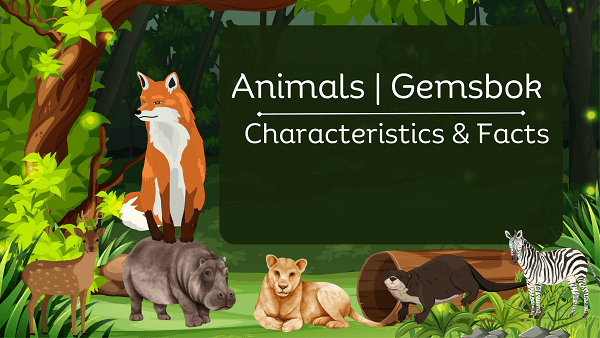
Gemsbok Definition | Characteristics & Facts
Gemsbok Definition
A Gemsbok (Oryx gazella), also known as the South African oryx, is a large antelope species native to the arid regions of Southern Africa. It belongs to the Oryx genus within the Bovidae family. Gemsboks are well-adapted to survive in harsh and dry environments, such as deserts, savannas, and semi-arid grasslands.
Gemsbok General Characteristics & Facts
Physical Characteristics
Gemsboks are large antelopes with a shoulder height of about 1.2 to 1.4 meters (4 to 4.6 feet) and a body length of around 2.1 to 2.5 meters (7 to 8.2 feet). They typically weigh between 180 to 240 kilograms (400 to 530 pounds). The most prominent feature of the gemsbok is their long, straight horns, which are present in both males and females and can reach up to 85 centimeters (33 inches) in length.
Habitat
Gemsboks are well-adapted to survive in arid and semi-arid environments, including deserts, savannas, and dry grasslands. They are found primarily in Southern Africa, including countries such as Namibia, Botswana, South Africa, Zimbabwe, and Angola.
Diet
Gemsboks are herbivores and predominantly graze on grasses. However, they are also known to consume leaves, fruits, and roots to supplement their diet. Interestingly, they can obtain most of their required water from the vegetation they eat, allowing them to survive in areas with limited access to water sources.
Social Structure
Gemsboks live in small herds, typically consisting of females, their young, and a dominant male. The dominant male is responsible for protecting the herd and is also in charge of mating with the females during the breeding season.
Adaptations
To cope with their arid environment, gemsboks have several adaptations. Their ability to obtain water from the vegetation they consume reduces their dependence on direct water sources.
Predators and Defense
Gemsboks face threats from predators like lions, cheetahs, hyenas, and leopards. They have excellent speed and agility, allowing them to outrun their predators. When cornered or threatened, gemsboks can defend themselves with their sharp horns, which are powerful weapons against potential threats.
Conservation Status
As of my last update in September 2021, gemsboks were listed as "Least Concern" by the International Union for Conservation of Nature (IUCN). However, their populations can be affected by human activities, such as habitat destruction, poaching, and competition with livestock for resources.
Symbolism
The gemsbok is the national animal of Namibia, and its image can be found on the country's coat of arms. It is also a popular animal in African art and often represented in various cultural contexts.
Read our Animals Encyclopedia with Complete Facts
Physical Characteristics Gemsbok
- Size: Gemsboks are large antelopes, with males being slightly larger than females. They typically stand at a shoulder height of about 1.2 to 1.4 meters (4 to 4.6 feet).
- Weight: Adult gemsboks weigh between 180 to 240 kilograms (400 to 530 pounds). Again, males are generally heavier than females.
- Horns: One of the most distinctive features of the gemsbok is its long, straight horns. Both males and females possess these horns, which can be formidable weapons and measure up to 85 centimeters (33 inches) in length. The horns are ridged and sharp, and they are often used for defense against predators and in territorial disputes.
- Coat Color: The gemsbok has a striking coat coloration that provides excellent camouflage in their arid habitats. The coat is mainly a mix of white and pale gray, while the face, legs, and flanks have distinct black and white markings. There is a black stripe that runs from the chin to the hooves on each side, and the tail has a black tuft at the tip.
- Facial Markings: Gemsboks have a distinctive black "racing stripe" that runs down the center of their face, from the forehead to the tip of the nose. They also have a white patch surrounding their eyes and a black stripe extending from the eye to the base of the horn.
- Body Markings: Along with the black and white markings on their flanks, gemsboks have a series of black bands on their legs, which help to break up their outline and provide further camouflage.
- Adaptations: Gemsboks are well-adapted to their arid environment. They have specialized kidneys that allow them to conserve water by producing concentrated urine. Their ability to obtain moisture from the vegetation they eat reduces their dependence on regular water sources.
- Speed and Agility: Gemsboks are known for their remarkable speed and agility, which they use to evade predators and escape danger. They can run at high speeds and change direction rapidly.
Continue To Explore All Animals That Start With G
Scientific Classification of Gemsbok
Kingdom: Animalia
Phylum: Chordata
Class: Mammalia
Order: Artiodactyla
Family: Bovidae
Subfamily: Hippotraginae
Genus: Oryx
Species: Oryx gazella
Key Locations of Gemsbok
- Namibia
- Botswana
- South Africa
- Zimbabwe
- Angola
- Other Countries
View All A-Z Animals List




